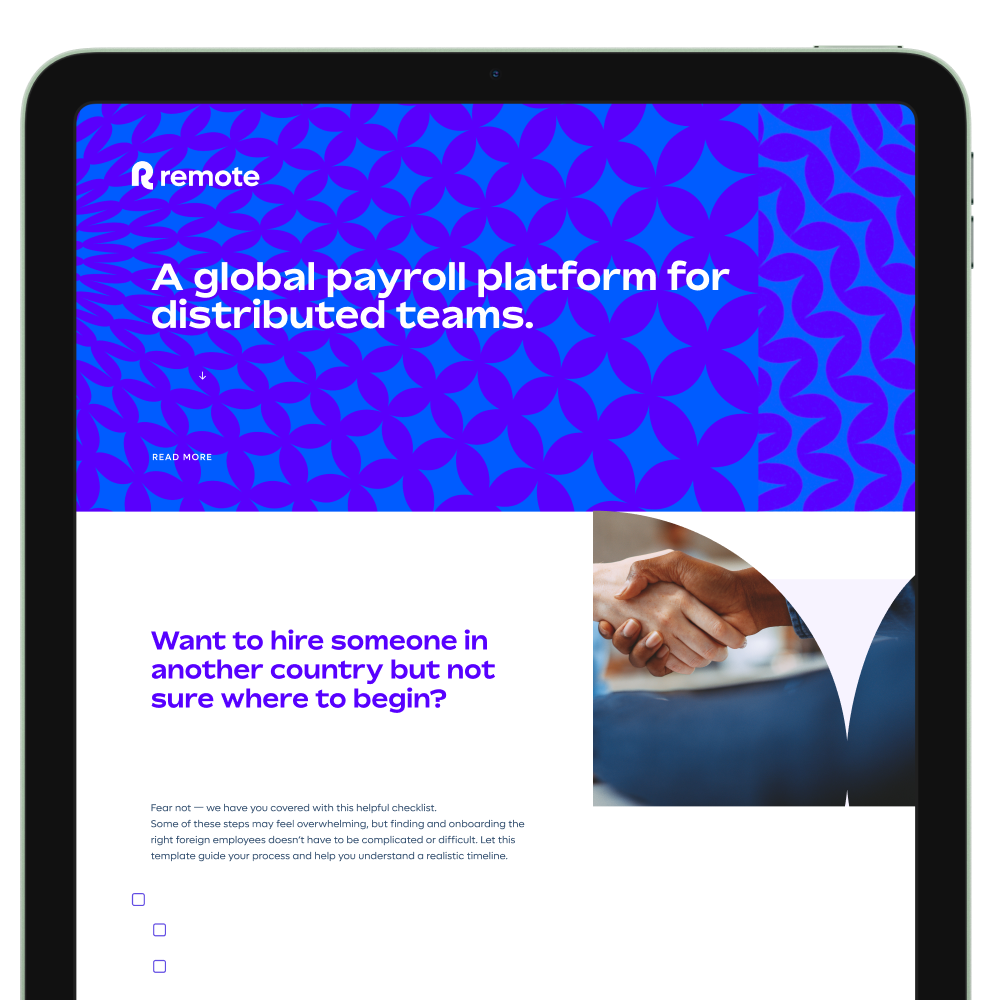
Product Updates — 7 min

Remote & Async Work — 14 min
If you could employ anyone from anywhere, what would you pay them? What would be fair?
To calculate compensation for remote employees, you have a few options. You can pay everyone based only on their experience and role, regardless of location. You can also consider the cost of living to adjust pay for your remote employees based on where they live. If neither option sounds appealing, you can make up your own formula to determine remote worker compensation.
No matter what you do or where you hire, one overarching principle remains the same: pay well to hire great people. With global employment solutions now allowing companies to hire top talent from all over the world, you cannot offer poor pay and expect to attract the best workers. When making your calculations, be sure your strategy keeps your salaries competitive.
Today’s businesses, even small ones, can compete for the best employees in the world. For instance, a young design firm in London can hire remote workers in South Africa, while a SaaS company in Mexico City may employ remote workers in India. Any business can hire anyone from anywhere, provided it compensates its remote members appropriately.
According to Payscale’s 2023 Best Practices Report, the top reason for labor shortages is inadequate pay. When you ensure your compensation benefits your talent and your company, your organization can be one of the employers people want to work for, giving you a leg up in the global employment market.
Here’s why nailing compensation for remote workers is so important:
Effective remote compensation strategies play a pivotal role in a company’s ability to attract and retain top-tier talent from a global pool. According to data from Pew Research, a staggering 63% of workers who decided to leave their jobs in 2021 cited low pay as one of the primary reasons for their departure.
Remote workers contribute just as much as their in-office counterparts, so it’s important to provide equitable pay for those living in different regions.
You also want to make sure you’re paying workers fairly based on their skill level so no one feels undervalued at work.
By looking at factors such as salaries in the local market and what employers are paying top talent globally, you can ensure you’re offering fair compensation.
Remote compensation strategies enable organizations to seamlessly integrate remote workers from different regions and cultures into their workforce, fostering diversity. A more diverse workforce can spur innovation and resilience.
When figuring out compensation calculations, you’ll want to consider several factors, including the cost of living and local and global benchmarks.
Cost-of-living adjustment (COLA) involves compensating employees based on the relative cost of living in their geographic location. It recognizes that the cost of necessities like housing, food, transportation, and healthcare can vary significantly from one place to another.
Adjusting salaries to reflect local costs helps ensure that employees can meet their basic needs comfortably.
Also known as geographic salary tiers or regional pay scales, the location-based tiers compensation strategy involves adjusting employees’ salaries based on their specific geographic location.
These tiers consider local job market conditions and other regional factors to determine appropriate salary levels for employees in different regions.
Market rate benchmarking involves assessing prevailing salary levels and compensation practices within the job market or industry to determine competitive and fair remuneration for a specific role. This process considers the particular skills, experience, and qualifications required for a role, as well as the demand for those skills in the job market.
Global benchmarking has a broader scope than market rate benchmarking, going beyond a specific region or market. It involves comparing compensation levels, employment terms, and practices across countries and international markets. It also considers the economic, legal, and cultural differences that exist between countries.
Different companies take different approaches to this challenge. Let’s look at a few examples.
Remote is fully transparent about how we compensate our team. As a fully remote, globally distributed company with hundreds of employees in dozens of countries all around the world, we have faced every conceivable challenge related to remote worker compensation and have created a system that works.
You can read our total compensation philosophy in our public handbook. At a glance, these are a few of the core tenets driving our remote compensation strategy:
Remote establishes a salary baseline at the 65th percentile within the market for each position based on cost of living and alignment to industry standards. That means salary considerations at Remote start at 15% above the market median. We pay well to attract great talent and to ensure our team members feel adequately compensated for their work. The 65th percentile is only the baseline — people may earn more or less.
We benchmark across teams and departments to ensure internal equity.
Regarding mandatory allowances or bonuses in certain countries — for example, the 13th-month pay in Mexico or the 8% holiday bonus in the Netherlands — we take a global approach to include country-by-country factors into our benchmarks and do not add them on top of other compensation.
Remote uses geographic pay differentials, also known as geo pay ranges, to set compensation ranges. These rangers allow us to pay higher than usual rates within countries and local areas.
We review compensation twice per year based on performance and market trends.
Finally, and most importantly, we conducted a thorough review in 2021 to identify and correct any gender-based gaps in compensation across our organization. This process is now built into our compensation review cycles and onboarding processes to ensure Remote pays everyone fairly.
As you can see, developing this plan was complicated, but the results are worth it to build a happy, thriving, fairly compensated global team.
Different companies take different approaches. Here are a few different compensation philosophies practiced by other global companies:
Basecamp simplifies salary calculations by paying everyone the same amount based on seniority level. All junior programmers make the same amount, as do all senior customer service representatives, and so on. Basecamp sets its salaries to the 90th percentile of the San Francisco market, so people who work at Basecamp are compensated very well.
This strategy guarantees Basecamp the ability to handpick top talent from around the world. Standardization of Basecamp salaries across levels of seniority also allows the company to consider raises versus promotions in the same conversation. The obvious downside is the considerable expense. San Francisco is one of the world’s priciest markets for talent, and paying remote employees on the high end of the San Francisco scale gets expensive quickly.
Buffer famously publishes the salaries of every person who works at the company. This commitment to transparency allows people who would like to apply to the company to get a good idea of what their salary might be if they were to apply.
Unlike Basecamp, Buffer pays its people differently depending on where they live. Its salary calculator provides a quick and easy way for companies and individuals to see what the company might pay a person in a specific position. The calculator uses a base salary for each role and multiplies it by that person’s cost of living. Base salaries are set at the 50th percentile of the San Francisco market.
Salary calculators like Buffer’s are nice because of their transparency, but they are not always the best approach. Highly qualified candidates living in areas with low costs of living may use the calculator and decide not to apply because they could make more money elsewhere. Even if Buffer would be willing to pay someone more, the existence of the calculator could dissuade top talent from applying in the first place.
Buffer understands this challenge, of course, which may be why the company creates so many different levels for each type of position. On Buffer’s salary publication chart is a variety of levels for engineers, customer advocates, and other roles. These levels make it difficult for outside candidates to assess exactly where they would fall in the hierarchy, limiting the utility of the calculator.
That said, Buffer’s commitment to transparency is a value in its own right. By creating a system with which everyone agrees, Buffer automatically filters out people who may not share the company’s values.
GitLab has a complex salary calculator for remote employees. They use the following formula:
1SF benchmark x Location Factor x Level Factor x Experience Factor x Contract Factor x Exchange Rate
Notable here is the San Francisco benchmark, which is also used by both Buffer and Basecamp. That benchmark is multiplied by location-specific data, which GitLab collects from a variety of sources to ensure accuracy. GitLab publishes the full strategy behind its remote employee compensation calculator online so that anyone can see and understand the process.
Like Buffer, GitLab further modifies salary calculations by level and experience. They add a bonus for employees who are contractors, as contractors have to cover more of their own costs and do not receive employee benefits.
GitLab’s formula guarantees accuracy and transparency in salary calculations, but maintaining a complex calculator with at least two variables that need constant maintenance (location factor and benchmark salary) is very time-consuming. This public formula has the same problems as Buffer’s simpler calculator but enjoys the advantage of higher fidelity in its calculations.
In practice, including other variables (level, experience) in the formula allows GitLab to compensate in a range and adjust where necessary. The calculator undergoes a review process upon receiving feedback, and all the inputs are thoroughly assessed as part of GitLab’s Annual Compensation Review.
Work through this checklist to help you stay compliant when you're employing across borders.


At companies with location-based compensation, a worker’s pay may change when the employee moves to an area with a different cost of living. GitLab’s policy on relocation, for example, is to require employees to receive written permission from a manager when planning to move.
Many companies claim they reduce compensation when employees relocate to areas with lower costs of living. In practice, however, such salary reductions are not always performed to the letter of the law. Forcing someone to take a pay cut to move home could sour the relationship between the worker and the company. This is an argument in favor of location-independent pay, or at least one in favor of unwritten leniency for employees who choose to move.
There is also the question of what happens when an employee moves from a place with a lower cost of living to a place with a higher one. Companies that enforce pay cuts must also provide pay raises if they want to stay true to their calculators. Employee movement can be a tricky thing in remote compensation, and practice does not always match policy.
In the debate over remote employee compensation, defenders of location-independent pay scales usually argue that companies pay for the value the employee brings to the company. Therefore, pay should be based on role and skill, not location.
In truth, location-independent pay remains unrealistic for most companies. As long as people in the world are willing to accept lower-then-maximum rates in areas where salaries are below the top tier, companies will always have some leverage in setting salaries to local rates. Companies seek profits and, as such, will optimize spending if they can do so without harming their retention rates.
After years of experience with GitLab, I certainly wouldn’t create a new salary calculator. Companies looking to create their own pay scales should use the calculator of GitLab and Buffer as a baseline and work from there. Remember, these companies put significant resources into maintaining their calculators. For these companies, remote employee salary calculators are just as useful for thought leadership and marketing purposes as they are for determination of employee pay. Whether a calculator makes sense for your business depends on the level of experience you want to attract and the amount you can pay people without straining your finances.
Remote workers evaluating offers should live by a simple rule: accept the salary that seems fair to you. When you start negotiations, you should have a figure in your head that you’re happy with. If the offer you get is way off, and there is little room to move that, weigh your options. You’ll likely earn less working remotely than you would working for a local company if that company is in San Francisco or New York. For most other locations, there is a good chance you’ll earn more than local companies offer.
Do not tell the company where you are currently negotiating what you were previously earning. That puts you in a bad position. Your best bet is to get an idea of what your potential colleagues are earning through independent research. Consider asking the company directly what other employees in your position earn. Again, companies should be honest about potential compensation while offering salaries that are both competitive and fair.
Ultimately, the global talent pool is a job market. Supply and demand meet each other at the right price. As an organization with deep experience in employing remote workers, both for ourselves and on behalf of our customers, we encourage remote-first organizations to prioritize the competitiveness of their compensation packages. That means you need to do as well or better than both local companies and other remote organizations if you want the best of the best.
Companies like Basecamp are rare, which is why Basecamp gets thousands of applications for every open position. Remote work will continue to grow in popularity and necessity, however, which means companies will continue to push the upper limit to build better teams. To hire the best people, paying slightly above the market rate in otherwise cheap markets is no longer enough.
Pay them better than anyone else and provide them with meaningful, challenging work. This is true for remote and co-located companies alike. Remote work provides incredible benefits and flexibility, so much so that many people are willing to take a pay cut for the privilege. However, if you do not pay people well, they’re not likely to stay for long.
If you need assistance with making offers to new employees, we can help. Remote takes care of payroll, benefits, taxes, and compliance for your company for one low flat rate. No matter where you hire, we can help you pay and manage your international team. Contact us today to learn more about our global employment solutions.
Start onboarding employees and contractors in minutes with Remote, G2’s top-ranked multi-country payroll software.

Subscribe to receive the latest
Remote blog posts and updates in your inbox.

Product Updates — 7 min

Minimum Wage & Compensation — 7 min

Global Payroll — 2 min

Newsroom — 5 min